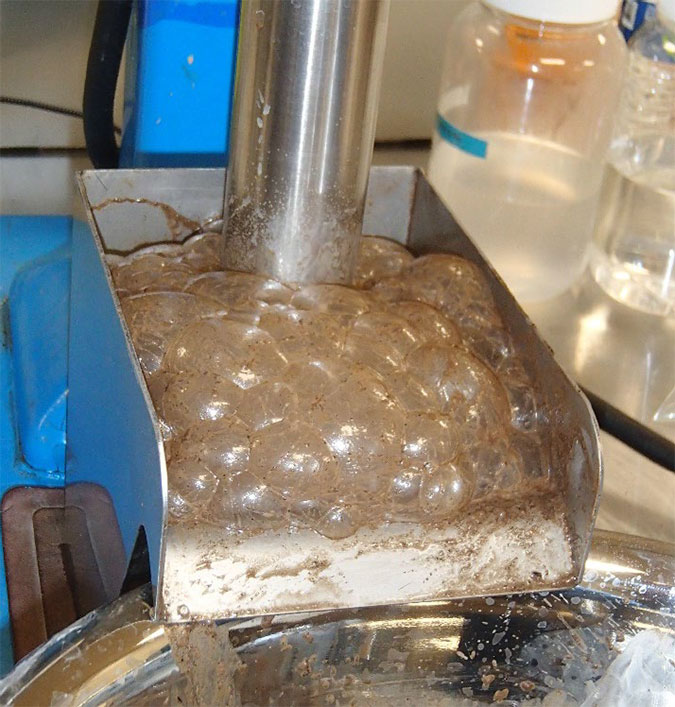August 10, 2023
Shimizu Corporation (President: Kazuyuki Inoue) recently initiated testing on the effectiveness of its soil washing technology on soil contaminated with per- and poly-fluoroalkyl substances (PFAS), which are known to be harmful to human health. The tests are being conducted in Texas, using PFAS-contaminated soil samples collected from a site in the United States. In anticipation of emerging demand, through this research work, we seek to demonstrate the effectiveness of our soil washing technology for utilization in PFAS-contaminated soil remediation projects.
PFAS are a category of synthetic chemical compounds that exhibit both hydrophobic and hydrophilic surfactant properties. These compounds have been used in a wide variety of products, such as coatings and fire-fighting foam because of heat resistant and water- and oil-repelling characteristics. At the same time, PFAS are referred to as “forever chemicals” due to their resistance to natural degradation in the environment. Since the 1990s, concerns have been raised about the persistence and accumulation of PFAS in the environment and living organisms. Examples include perfluorooctane sulfonate (PFOS) and perfluorooctanoic acid (PFOA), which have been designated as regulated substances under the Stockholm Convention on Persistent Organic Pollutants (POPs Convention). Regulations of PFAS compounds are being tightened worldwide.
In Japan, in response to the decision at the POPs Convention, PFOS/PFOA have been designated as Class I Specified Chemical Substances under the Chemical Substances Control Act. As such, they are subject to prohibitions and restrictions on manufacturing, use, and import/export. In 2020, a provisional guideline value for target water quality was established for tap water, public water, and groundwater (with a combined total of 50 ng/L for PFOS and PFOA). However, environmental contamination has become evident, with PFAS levels exceeding the provisional guideline value, being detected in areas around facilities such as airfields and bases, where large quantities of fire-fighting foam have been used in the past.
Under these circumstances, we have been developing remediation technology for PFAS-contaminated soil and groundwater since fiscal 2021, in anticipation of future tightening of regulations. For groundwater pollution, we have applied foam fractionation, which involves separating and collecting contaminants through adhesion to surface of foam. In a PFAS-polluted water field test conducted in Okinawa Prefecture in fiscal 2022, we successfully purified polluted water containing more than 12 times the national provisional guideline value (634 ng/L) to treated water (clean water) of less than 1 ng/L.
Meanwhile, for contaminated soil, we have been working on the application of our soil washing technology, for which we have a proven track record. The distinctive characteristic of our soil washing technology is that it enhances the quality of the clean soil using flotation, in which contaminant-bearing particles are separated from soil and attached to the surface of air bubbles for further separation from water. Our soil washing system with hydrocyclone and flotation makes it possible to achieve high removal efficiencies. Clean soil can be reused for backfilling and other purposes. The greatest advantage of soil washing is the reduction of the amount of soil needing further treatment such as incineration. Therefore, applying this technology reduces overall remediation costs. To date, we have utilized our soil washing technology to clean approximately 3.2 million tons of soil, mainly contaminated by heavy metals, mineral oils, cyanides, agrichemicals, radionuclides, and dioxins.
With the soil washing treatability study being conducted in the United States, we seek to develop a PFAS-contaminated soil remediation technology focused foremost on hydrodynamic classification and flotation technologies to achieve high removal efficiency.
Going forward, we not only aim to apply our technology in soil remediation projects in the United States, where PFAS-contaminated soils have already become a pressing concern and proactive regulatory efforts are underway, especially at military sites; but also plan to expand our technical development for soil remediation in Japan. This includes facilities with potential widespread dispersion of PFAS-containing fire-fighting foam and where products were manufactured using PFAS.
≪For Reference≫
PFAS separation and collection by flotation

The information contained in this news release is the current information on the date of publication. Please be aware that this information may have changed by the time you view it. Please contact the company to inquire for further details.
